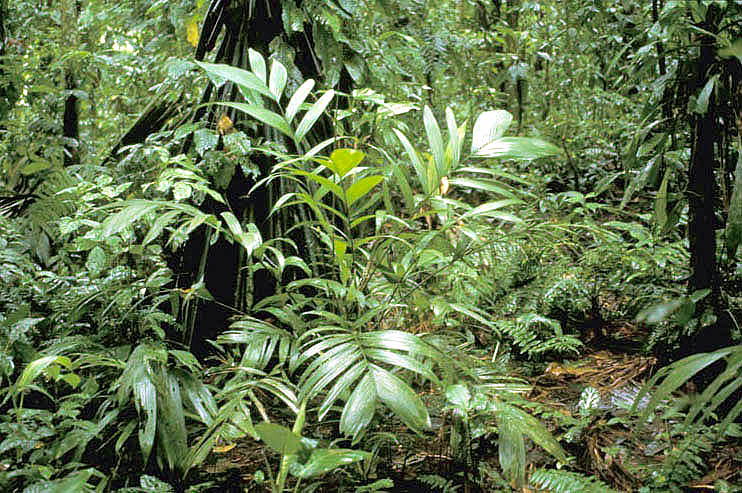Bactris gasipaes var. gasipaes
Morphology:
Subcanopy palm. Stems clustered, to 15 m tall and 15 cm in diameter. Leaves 2-3.5 m long; pinnae to 125 on each side, inserted in groups and spreading in different planes, the central ones to 80 cm long and 4 cm wide. Inflorescence 40-70 cm long; branches up to 50, to 35 cm long. Fruit red, smooth, 3-5 cm in diameter; fruiting perianth with a very small calyx and a much longer, briefly lobed corolla; staminodial ring absent.
Distribution:
Planted or naturalised, always near human settlements, in humid lowland areas throughout tropical America.
Common
names:
Amarija
–
Zaparo
(Borchsenius et al. 1998).
Cano-chi
–
Chachi
(Barfod & Balslev 1988).
Canuchi
–
Chachi
(Lindskoog & Lindskoog 1964).
Chonta
–
Quichua
(Balslev & Barfod 1987 and additional references).
Chonta duro
–
Spanish
(Balslev & Barfod 1987 and additional references).
Chontaduro
–
Spanish
(C. Ceron #195).
Chunda
–
Quichua
(Orr & Wrisley 1981 and additional references).
Chunda duru
–
Quichua
(Ponce 1992).
O´ma
–
Cofán
(Borman 1976 and additional references).
Pahua chunda
–
Quichua
(Orr & Wrisley 1981).
Pifayo
–
(Gonzalez et al. 1985).
Pijuayo
–
(Gonzalez et al. 1985).
Puca chunda
–
Quichua
(Orr & Wrisley 1981).
Quillu chunda
–
Quichua
(Orr & Wrisley 1981).
Shalin chunda
–
Quichua
(Orr & Wrisley 1981).
Tewe
–
Waorani
(Lescure et al. 1987).
Uwi
–
Achuar, shuar
(Descola 1989 and additional references).
Uses:
A root decoction is drunk to cure diarrhea
(R. Marles #43).
Fruit harvest is done with a long pole with a hook or by climbing Inga or Cecropia spp. trees purposely planted next to the palm
(Borchsenius et al. 1998 and additional references).
Fruits are edible, boiled or roasted
(A. Barfod #60022 and additional references).
Fruits are often sold on lowland markets
(B. Bergmann #97804 and additional references).
Fruits may be smoked and stored, and a drink is often made from grated fruits
(H.V. Pinkley #95A).
The palm heart is edible, and plantations for industrial production of palm hearts is established in several places in Ecuador, including the area around Santo Domingo de los Colorados in W Ecuador and Puyo in the E Andean foothills
(Borchsenius et al. 1998).
The stem is used for house pooles and floor, fish traps, spears, blowguns, marimba keys, and other crafting
(Barfod & Balslev 1988 and additional references).
|
Latest posts by admin (see all)
- Aluminium Rattan Garden Furniture Design Ideas - September 11, 2019
- Popular Gardens and Parks in Sheffield, United Kingdom - September 18, 2018
- How New Eco-Friendly Garden Benches Help Plants and Consumers in the UK - February 26, 2018




Discussion: